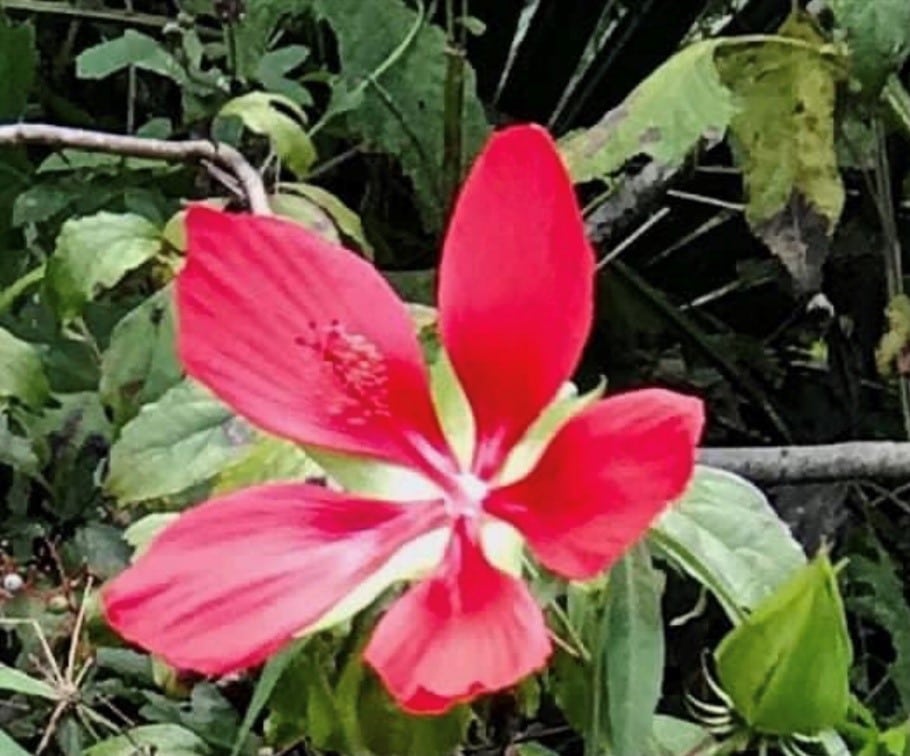Photo by Carole Adams
We are certainly fortunate to have a myriad of year around flowers in our region – hence the Spanish explorer’s name “La Florida.” One such flower is the stunning scarlet swamp hibiscus (Hibiscus coccineas) occurring naturally in swamps, marshes and ditches, from southern Georgia and Alabama south into central Florida. It’s also called rose mallow and Texas star. Typically, in our area, you will encounter swamp hibiscus along the St. Johns River and its tributaries where it towers above cattail, primrose willow, maidencane, sawgrass, pickerelweed and other emergent wetland plants.
In 1774 this plant was encountered and described by colonial naturalist, author and artist William Bartram. He described the hibiscus as “most stately…embellished with large, expanded crimson flowers.” During his travels in Florida, he introduced the world to over 250 native plants and was given the Indian name “Puc-puggy” – the flower hunter. His work, The Travels of William Bartram was published in 1791. He visited St. Augustine, Fort Picolata and tried his hand at an indigo plantation at Little Florence Cove, near Orangedale. Putnam County is the epicenter of Bartram’s explorations boasting thirty-four known sites.
The native scarlet swamp hibiscus is one of the more impressive large-flowered summer bloomers. Its deep red flower reaching sizes of 6-8 inches across can be spotted from a hundred feet away. They are fast-growing herbaceous perennial plants. Established plants can have several stems that can grow up to 10 feet tall and 3-6 feet wide. They are close relatives of many of the tropical hibiscus seen commonly in the landscapes of southern and central Florida. Unlike their tropical counterparts, however, the northern cousin is much more cold temperature tolerant, vigorous, long lasting, and they have larger flowers. These brilliant red flowers have 5-petals, and each blossom lasts only a day; however, new flowers will continue to bloom all summer. The leaves are divided like the fingers on a hand, into 3-7 narrow, pointed, serrated or jagged lobes.
In our region, these plants emerge from the ground in the spring and bloom throughout the summer. A prolonged hard freeze can kill the above-ground growth but below-ground roots overwinter and produce hardy new shoots the following spring.
Hibiscus as a group have been hybridized and cross-bred into many forms, colors, flowers and landscape and ornamental uses. Many are salt tolerant and can grow in brackish water directly in the tidal zones. Some are well suited to semi-aquatic conditions and can be a great way to plant freshwater marshy or soggy areas in your yard that are otherwise maintenance problems. Flourishing in the heat, swamp hibiscus does best in full sun and mildly acidic soil. They even do well in containerized situations, which offers mobility if needed, to this eye-catching specimen particularly during chilly winter months.
The swamp hibiscus can be used as a specimen plant in our landscape but requires a wet site or much watering. It can also be used around ponds or streams. This hibiscus requires full sun or partial shade. It can be grown from seeds or propagated by division of the stems and roots.
The flowers are attractive to many pollinators such as butterflies, hummingbirds, bees, and birds. A good local spot to see scarlet swamp hibiscus is on the north side of SR 207, in the floodplain wetlands, at the Deep Creek Bridge crossing about one mile east of Hastings.
Mike Adams is an ecologist, educator, researcher and author. He has lived and worked along the St. Johns River for 43 years. Email: adamscience@windstream.net
